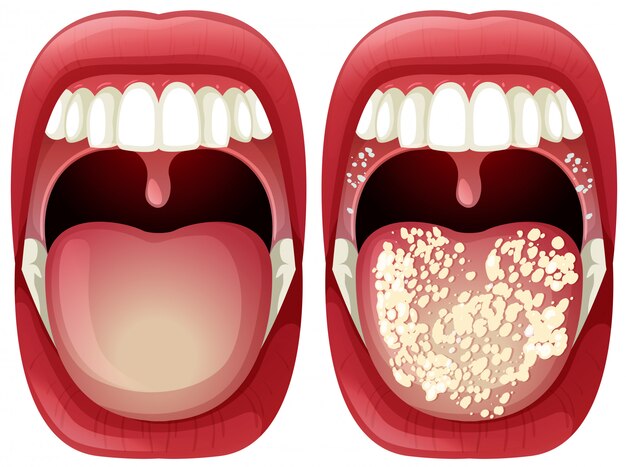Canker sores, another name for mouth ulcers, are a common oral health problem that many people encounter at some point in their lives. They are small, painful sores that develop inside the mouth. They can form on the inner lining of the cheeks, lips, tongue, gums, and the roof of the mouth.
Brushing hard could cause ulcers. Any kind of physical trauma will easily turn into an ulcer.
While they are generally harmless and non-contagious, oral ulcers can be very uncomfortable and may interfere with daily activities such as eating and speaking. Let’s get deeper and understand the types of ulcers, Preston, and the treatment.
Types of ulcers based on their site of occurrence
Buccal Mucosa Ulcers (Cheek Ulcers)
A buccal mucosa/cheeks ulcer is an open sore or lesion on the moist inner lining of the cheeks, a sensitive area of the oral cavity.
- Location: Inside the cheeks
- Appearance: Buccal mucosa ulcers are typically round or oval-shaped with a white or yellowish centre and a red border. They can vary in size, ranging from small pinpoints to larger sores.
- Symptoms: These ulcers can cause discomfort and pain, especially when eating, drinking, or brushing the teeth. The location and size of the ulcer can affect how painful it is.
- Causes: Buccal ulcers can be caused by trauma (such as accidental biting), irritation from sharp or abrasive foods, ill-fitting dental appliances, chemical irritants (tobacco or alcohol), infections (viral or bacterial), systemic conditions (like Behçet’s disease or IBD), and allergies.
- Duration: Most buccal mucosa ulcers are self-limiting, meaning they heal on their own within one to two weeks. However, larger or more severe ulcers may take longer to heal.
Labial (Lip)Ulcers:

Labial ulcers are painful, open sores on the lips caused by trauma or infections, distinct from cold sores caused by the herpes simplex virus.
- Location: On the surface of the lips, the visible and sensitive parts of the oral cavity.
- Appearance: These ulcers are often round or oval-shaped and may have a white or yellowish center with a red border. The appearance can vary based on the cause and individual factors.
- Symptoms: Labial ulcers can be associated with pain or discomfort, particularly when eating, drinking, or moving the lips
- Causes: Trauma (biting, injury), infections (viral or bacterial), autoimmune conditions (Behçet’s disease, lupus), allergies, and ill-fitting dental appliances.
- Duration: They are also self-limiting, given proper care, and may heal in 10–14 days.
Tongue Ulcers

Tongue ulcers are painful canker sores on the tongue, often benign and healing on their own, causing discomfort during eating, drinking, and speaking activities.
- Location: Tongue ulcers can occur on the top, sides, or underside of the tongue.
- Appearance: They typically present as round or oval-shaped sores with a white or yellowish center and a red border. The size of the ulcers can vary.
- Symptoms: Tongue ulcers are often accompanied by pain or discomfort, particularly when consuming hot, spicy, or acidic foods. Speaking and brushing the teeth may also be challenging.
- Causes: Trauma (biting, hot foods), infections (viral or bacterial), nutritional deficiencies, autoimmune conditions (like Behçet’s disease), and systemic diseases.
- Duration of healing: These ulcers are also self-healing and may heal within 4–14 days
Gingival (Gum) Ulcers:
Gingival ulcers, or gum lesions, are open sores or lesions on the gums, causing pain, swelling, and discomfort, distinct from other gum conditions like gingivitis or periodontitis.
- Location: On the gums, soft tissue surrounding the teeth
- Appearance: These ulcers can present as round or oval-shaped sores with a white or yellowish center and a red border. These ulcers are usually less than 5 mm in diameter
- Causes: Trauma (biting, hot foods), infections (viral or bacterial), nutritional deficiencies, autoimmune conditions (like Behçet’s disease), and systemic diseases.
- Symptoms: Gingival ulcers may cause pain, swelling, and discomfort, especially during activities like brushing, flossing, or eating.
- Duration of healing: These ulcers are also self-healing and may heal within 4–14 days.
Palatal Ulcers
Palatal ulcers are painful, open sores on the hard or soft palate, affecting eating, drinking, and speaking activities.
- Location: Ulcers on the roof of the mouth (hard or soft palate).
- Appearance: Painful, clustered ulcers of 1–5 mm in diameter.
- Symptoms: pain, discomfort, and difficulty eating and swallowing.
- Causes: trauma (from hot foods or aggressive brushing), infections (viral or bacterial), allergic reactions, and systemic conditions.
- Duration of healing: Like all oral ulcers, these ulcers are also self-healing and heal within 10–14 days.
How do you prevent mouth ulcers?
Good oral hygiene:
- Brush on a regular basis with fluoride toothpaste and a toothbrush with soft bristles.
- Flossing is important to remove plaque and prevent gum irritation.
- Avoid Trauma:
- Be cautious while eating to avoid accidental biting of the tongue or cheeks.
- Use caution when brushing your teeth to prevent mechanical trauma.
- Dietary Habits:
- Avoid foods that may trigger or irritate oral ulcers, such as those that are very spicy, acidic, or abrasive.
- Maintain a balanced diet rich in vitamins and minerals, especially B vitamins, iron, and folate.
- Manage Stress:
- Engage in stress-reduction practices like yoga, deep breathing, and meditation.
- Oral Appliance Care:
- Ensure that dental appliances, such as braces or dentures, fit properly to prevent irritation.
- Avoid tobacco and excessive alcohol:
- Quit smoking and avoid excessive alcohol consumption.
What is the treatment available for ulcers?
- Topical Medications:
- Topical gels or ointments containing ingredients like benzocaine or steroids can help relieve pain and promote healing.
- Pain Relief:
- Pain relievers, such as acetaminophen or ibuprofen, can be used to manage pain.
- Avoiding Irritants:
- Identify and avoid factors that may contribute to the development of ulcers, such as certain foods or oral care products.
- Maintaining oral hygiene:
- Continue with gentle brushing and regular oral hygiene practices.
- Hydration:
- Ensure adequate hydration by drinking plenty of water.
- Nutritional Supplements:
- If nutritional deficiencies are suspected, consider supplements under the guidance of a healthcare professional.
Treatment for ulcers varies based on the cause, such as infections, autoimmune disorders, or systemic illnesses. Seeking expert help is crucial for accurate diagnosis and personalized treatment plans.
What if the ulcers are recurring or not healing?
If oral ulcers, including those on the palate, tongue, buccal mucosa, or lips, are recurring or not healing as expected, it’s important to seek professional advice from a dentist or healthcare provider. Here are steps to take if you are experiencing persistent or recurrent ulcers:
- Consult a healthcare professional:
- Schedule an appointment with a dentist or an oral health professional for a thorough examination.
- They can evaluate the ulcers, determine the potential causes, and recommend appropriate treatment.
- Provide detailed information:
- Be prepared to provide detailed information about your oral hygiene practices, dietary habits, any recent changes, and the history of the ulcers, including
- When they first appeared,
- How often do they recur?
- If there are any associated symptoms.
- Undergo diagnostic tests:
- In some cases, diagnostic tests may be necessary to identify the underlying cause.
- This may include blood tests, cultures, or imaging studies.
- Review Medications:
- If you are taking any medications, inform your healthcare provider.
- Some medications can contribute to the development of oral ulcers as a side effect.
- Consider Allergies:
- If allergies are suspected, your healthcare provider may recommend allergy testing to identify potential triggers.
- Address the underlying conditions:
- If the ulcers are associated with an underlying medical condition, such as an autoimmune disorder or nutritional deficiency, the healthcare provider will develop a treatment plan to address the root cause.
- Receive targeted treatment:
- Depending on the diagnosis, your healthcare provider may recommend specific medications, topical treatments, or interventions to promote healing and prevent recurrence.
- Follow prevention strategies:
- Implement preventive measures, such as good oral hygiene practices, dietary modifications, stress management, and avoiding known triggers.
- Follow-Up Visits:
- Attend follow-up visits as recommended by your healthcare provider to monitor progress and make any necessary adjustments to the treatment plan.
Conclusion
Whether it’s the discomfort of a tongue ulcer, the pain of a labial sore, or the irritation of a buccal mucosa ulcer, treating these problems as soon as possible assures not just relief from symptoms but also the diagnosis and therapy of any underlying health issues.
The journey to a healthier, ulcer-free mouth involves a collaborative effort between individuals and healthcare professionals, combining preventive measures with targeted treatments for optimal oral well-being.
Finally, prioritize your oral health, pay attention to changes, and don’t be afraid to seek expert help if you have persistent or recurring mouth ulcers. A healthy mouth contributes not only to physical well-being but also to overall quality of life.


